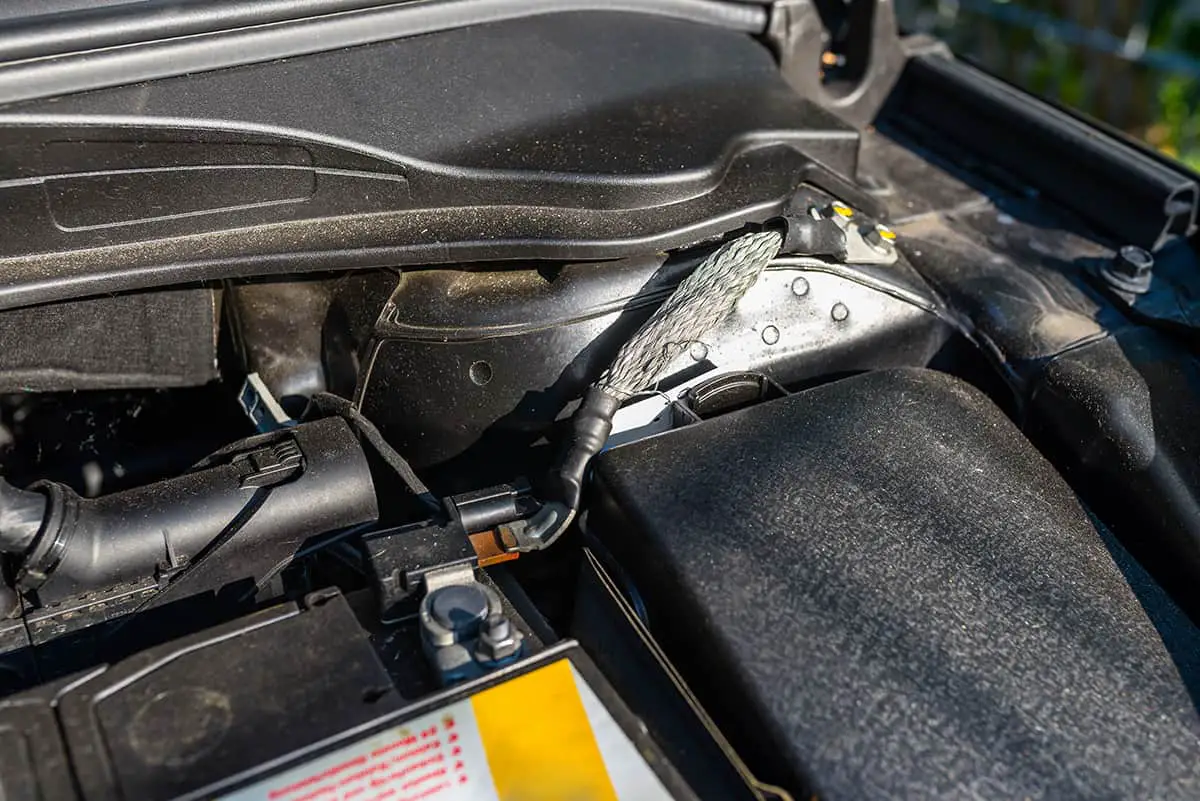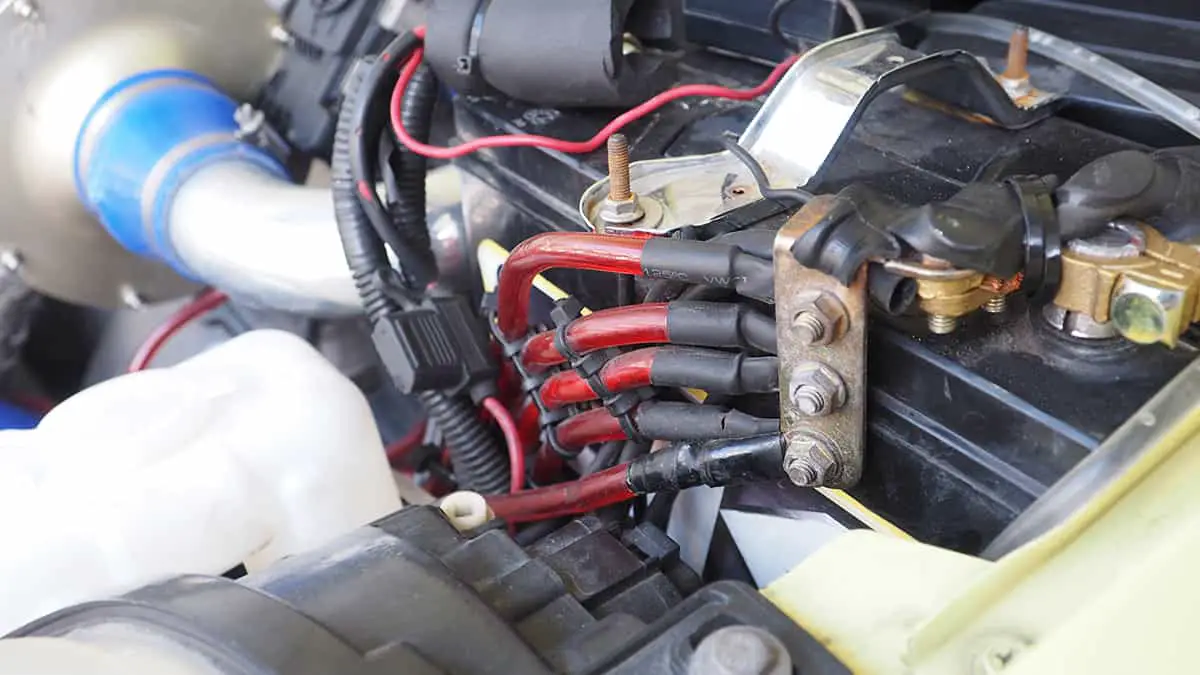A car engine ground wire is an electrical conductor that provides a direct path of low resistance between the car’s negative battery terminal and the engine block or other ground points. The ground wire also helps ensure proper engine performance by allowing the battery to provide full voltage to the starter and other electrical components. If your car is experiencing battery or electrical problems, you should know where to look for the engine ground wire.
The engine ground wire is typically located near the battery or engine block and is connected to the negative (-) battery terminal and the engine block or another ground point. In some vehicles, the ground wire is connected to the frame or chassis of the car, while in others, it is connected directly to the engine block.
In this guide, I’ll explain in greater detail what the engine ground wire is, how to ground the engine of your car, and the symptoms of a bad ground wire.
What Is the Engine Ground Wire?
The engine ground wire, also known as the negative battery cable or strap, is an essential component of a vehicle’s electrical system. This thick black cable runs from the car battery negative terminal to the chassis of the vehicle and acts as the conduit for all electrical currents in the vehicle.
A well-functioning engine ground wire is essential for the proper functioning of the vehicle’s electrical system. It helps to ensure that all electrical components, such as the lights, radio, and alternator, receive the power they need to operate correctly. If the engine ground wire is damaged or poorly connected, it can cause a variety of electrical problems that can impair the performance of the vehicle.
Where Is the Engine Ground Wire Located?
For the most part, the engine ground wire connects the battery’s negative (-) terminal to the engine block or another ground point and is typically situated close to the battery or engine block. The ground wire may be connected to the car’s frame or chassis, while in others it may go straight to the engine block.
Here’s a step-by-step guide on how to locate the engine ground wire in your car.
- Open the hood of the vehicle and locate the battery and follow the negative battery cable to where it is connected to the engine or chassis of the vehicle.
- Identify the connection point, which is a thick, heavy gauge wire or cable attached to a bolt or stud that is bolted to the engine or frame.
- Check for other ground points. In some vehicles, the engine ground wire may be connected to the frame or chassis of the car at multiple points, so it is important to check for other ground connections in addition to the one near the battery.
If you still don’t know where the engine ground wire is, I highly suggest that you open the owner’s manual. It will provide specific information on the location of the engine ground wire, including diagrams and illustrations.
How to Ground the Engine

Grounding a car engine involves connecting the negative terminal of the battery to the engine block or another grounded component of the vehicle. This helps to ensure a complete electrical circuit and a stable flow of electrical current throughout the vehicle.
After opening the hood of your car and wearing the proper PPE, here’s how you can ground the engine:
- Locate the car battery
- Find the negative (-) battery terminal. It should have a black cable connected to it.
- Look for the engine block or grounded component. It will typically be near the battery and is identifiable by a large metal component connected to the battery cable.
- Use a wrench to loosen the negative cable from the battery and tighten the cable to the grounded component or engine block.
Symptoms of a Bad Engine Ground Wire
A bad engine ground wire can lead to numerous issues, including:
1. Engine stalling or misfiring
The ground wire provides a path for electrical current to flow from the battery to the engine. If the ground wire is damaged or not properly connected, the flow of electrical current can be disrupted, causing issues with the ignition and fuel systems.
For example, the ignition system may not receive enough current to properly fire the spark plugs, leading to engine misfires. Similarly, the fuel system may not receive enough current to operate the fuel injectors, causing the engine to stall.
2. Dimming or flickering of lights
The ground wire is also responsible for providing a stable electrical connection for the vehicle’s electrical system. If the ground wire is damaged or not properly connected, it can cause voltage fluctuations in the electrical system, which can affect the performance of the lights.
If the ground connection is weak, the voltage supplied to the lights may fluctuate, causing the lights to dim or flicker. This is because the electrical current is not flowing smoothly, and the amount of current reaching the lights is inconsistent.
3. Electrical component failure
The engine ground wire provides a path for electrical current to flow from the battery to the engine, and if it is damaged or not properly connected, it can cause voltage fluctuations and electrical interference in the system.
These voltage fluctuations and electrical interference can cause damage to sensitive electrical components, such as the alternator, sensors, and other electronic control modules. Over time, this damage can lead to component failure and result in various issues with the vehicle, such as rough idling, stalling, or warning light illumination.
4. Engine cranking slowly or not starting
If the ground wire is damaged or not properly connected, it can affect the amount of electrical current that reaches the starter motor, which can in turn affect its ability to engage and start the engine.
A weak ground connection may cause the starter motor to receive an insufficient electrical current, which can cause it to turn slowly or not at all. In some cases, the starter motor may receive enough current to engage but not enough to turn the engine over, resulting in a slow crank or no-start condition.
5. Poor fuel efficiency
A bad engine ground wire can cause issues with the engine’s control systems, including the fuel injection and ignition systems. If the ground wire is damaged or not properly connected, it can affect the flow of electrical current to these systems, leading to inconsistent performance and reduced fuel efficiency.
If the ground connection is weak, the fuel injectors may not receive enough current to operate properly, leading to inconsistent fuel delivery and reduced engine performance. Similarly, issues with the ignition system, such as misfires or misaligned spark timing, can also affect fuel efficiency by causing the engine to run less smoothly and consume more fuel.
How to Replace a Bad Engine Ground Wire
If you suspect your engine ground wire is bad, you can replace it on your own by following these steps:
- Locate the ground wire.
- Use a pair of pliers or a wrench to loosen the nuts securing the ground wire to the engine or frame.
- Attach the new ground wire to the engine or frame in the precise location as the old ground wire.
- Use the pliers or wrench to fasten the nut in place.
- Brush the car battery’s negative (-) terminal with a wire brush to remove debris and corrosion.
- Connect the other end of the new engine ground wire to the car battery’s negative terminal.
- Start your car and test the electrical system.
If you don’t feel confident in your DIY mechanic skills, I suggest having a professional mechanic do the deed for you.






